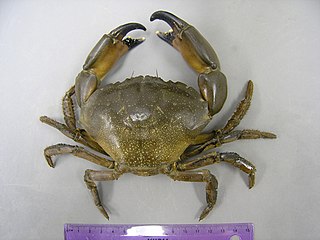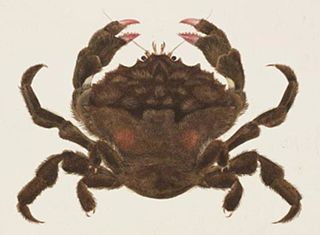Related Research Articles

Cherax parvus is a species of crayfish in the family Parastacidae. It is only known from its type locality – the Upper Tully River catchment in the Cardwell Range of north-eastern Queensland – and is listed as data deficient on the IUCN Red List. It was discovered in a rainforest catchment in a highland of northeastern Queensland during a Queensland Museum expedition to the upper Tully River area in November 1992. It is one of the smallest species in the genus. No species of Cherax has been considered endemic to wet upland or highland areas before it was discovered; most previous records were from elevations less than 400 meters. It also has several morphological features unique to the genus, and does not appear closely related to any extant species, suggesting a long period of geographic isolation.

Menippe adina is a species of crab, sometimes called the Gulf stone crab or Western Gulf stone crab. It is very closely related to the Florida stone crab, Menippe mercenaria, of which it is sometimes considered to be a subspecies.

Latreilliidae is a small family of crabs. They are relatively small, long-legged crabs found on soft bottoms at depths of up 700 metres (2,300 ft) in mostly tropical and subtemperate waters around the world. Their carapace is very small and doesn’t cover the bases of their legs, which protrude from the cephalothorax in a spider-like manner. The family and its type genus are named after Pierre André Latreille. The oldest known fossils from the Latreillidae have been dated to the middle of the Cretaceous period. It comprises seven extant species.

Goneplax rhomboides is a species of crab. It is known by the common name angular crab because of its angular carapace. Although it is also called the square crab, its shell is in fact more trapezoidal than square. This species is also known as the mud-runner because they are able to run away quickly when threatened.

Eumunida picta is a species of squat lobster found in the deep sea. The species is strongly associated with reefs of Lophelia pertusa, a deep-water coral, and with methane seeps. It is abundant in the western Atlantic Ocean, where it is found from Massachusetts to Colombia.

Pagurus sinuatus is a large species of hermit crab found in Australia and the Kermadec Islands. It is red or orange in colour with coloured bands on the legs and patches on the body.

The family Homolidae, known as carrier crabs or porter crabs, contains 14 genera of marine crabs. They mostly live on the continental slope and continental shelf, and are rarely encountered. Members of the Homolidae have their fifth pereiopods in a sub-dorsal position, which allows them to hold objects in place over the rear half of the carapace. The objects carried include sponges, black corals and gorgonians, and this behaviour may be a defence mechanism against predators. Some species have been observed carrying living sea urchins in a symbiotic relationship which allows them to benefit from the protection of the urchin's dangerous spikes.

Neoglyphea inopinata is a species of glypheoid lobster, a group thought long extinct before Neoglyphea was discovered. It is a lobster-like animal, up to around 15 centimetres (5.9 in) in length, although without claws. It is only known from 17 specimens, caught at two sites – one at the entrance to Manila Bay in the Philippines, and one in the Timor Sea, north of Australia. Due to the small number of specimens available, little is known about the species, but it appears to live up to five years, with a short larval phase. A second species, previously included in Neoglyphea, is now placed in a separate genus, Laurentaeglyphea.

Loxorhynchus grandis, commonly known as the sheep crab or spider crab, is a species of crab in the family Epialtidae. It is the largest crab found on the California coast. The species was first described to science by William Stimpson in 1857. The type specimen was collected on the coast of California, near San Francisco. Fossils from the late Miocene epoch indicate that this species is at least 11.63 to 5.333 million years old.

Oregonia bifurca, commonly known as the split-nose crab or the split-nose decorator crab, is a species of crabs belonging to the family Oregoniidae. It is a rare deep-water species that inhabits the tops of seamounts and guyots in the northeastern Pacific Ocean; from the Aleutian Islands, the Bering Sea, the Hawaiian–Emperor seamount chain, to the waters off British Columbia. It is closely related to the more common shallow-water species Oregonia gracilis, the graceful decorator crab.
Palaemonella burnsi is a species of shrimp in the family Palaemonidae, from Maui, Hawaii. This species is closest to Palaemonella lata, which it resembles in the broad scaphocerite in which the lamella overreaches the final tooth, and in the unarmed merus of the second pereiopods. It differs from P. lata in the much longer fused part of the two branches of the upper antennular flagellum, in the relatively much longer fingers and shorter palm of the second legs, in the unarmed carpus of the second legs. It is named after John A. Burns, Governor of Hawaii, for declaring the Ahiki Kinau area a nature reserve.
Periclimenes pholeter, is a species of shrimp belonging to the family Palaemonidae. The species is closest to Periclimenes indicus, P. obscurus and P. toloensis, resembling these species in the presence of an epigastric tooth on the carapace, the shape of the abdomen, the spinulation of the carapace, and the unarmed fingers of the first chelipeds. P. pholeter most resembles P. indicus by the elongatecarpus and long fingers of the second pereiopods, differing in these features from P. toloensis, which has the fingers slightly less than half as long as the palm. In P. obscurus the fingers are shorter than the palm, but the carpus is about as long as the palm. From P. indicus, this species differs: by the greater size; by the much higher rostrum and the greater number of ventral rostral teeth; by the shorter eye; by the less slender antennular peduncle; by the more deeply cleft upper antennular flagellum; by the more robust scaphocerite; by the fingers of the first pereiopods ; by the more slender pereiopods, especially the fifth, which is much longer than the ischium.
Alpheus tricolor is a crustacean belonging to the family of snapping shrimp. It was first isolated in Indonesia and Sri Lanka. It counts with a setose carapace, an acute rostrum, shallow adrostral furrows and a basicerite with a strong ventrolateral tooth. The lamella of its scaphocerite is not reduced, with an anterior margin that is concave. Its third maxilliped counts with an epipodial plate bearing thick setae, while its first chelipeds are found with their merus bearing a strong disto-mesial tooth; its third pereiopod has an armed ischium, with a simple and conical dactylus. Its telson is broad, distally tapering, with 2 pairs of dorsal spines. The species is named after its characteristic colour pattern, including white, red and orange.

Alpheus fasqueli is a crustacean belonging to the family of snapping shrimp. It was first isolated in Sri Lanka. It counts with a setose carapace, an acute and carinate rostrum, and unarmed orbital hoods. Its basicerite has a strong ventrolateral tooth. The lamella of its scaphocerite is not reduced. Its third maxilliped counts with an epipodial plate bearing thick setae, while its first chelipeds are found with their merus bearing a strong disto-mesial tooth; its third pereiopod has an armed ischium, with a simple and conical dactylus. Its telson is broad, distally tapering, with 2 pairs of dorsal spines. The species is named after Frédéric Fasquel, a photographer who contributed rare shrimp specimens for the Muséum national d'histoire naturelle.

Lauridromia dehaani is a species of crab in the family Dromiidae. It is native to the Red Sea and the western Indo-Pacific. It often carries a piece of sponge on its carapace by way of camouflage, and if unable to find a suitable piece of sponge, carries an empty bivalve shell, a sprig of seaweed or a piece of debris instead.

Ashtoret lunaris, also known as the yellow moon crab, spotted moon crab or box crab, is an Indo-Pacific species of carnivorous crab which is a member of the family Matutidae. It has been recorded in the eastern Mediterranean since 2010, likely reaching it via the Suez Canal from the Red Sea by.

Hyastenus hilgendorfi is a species of spider crab from the family Epialtidae, classified in the sub-family Pisinae, from the Indo-Pacific region. It has been recorded in the Suez Canal and there have been a few records in the eastern Mediterranean, making it a Lessepsian migrant.
Notopus dorsipes is a species of frog crab from the family Raninidae which has an Indo-Pacific distribution and which has recently spread into the eastern Mediterranean. It is the only extant species in the genus Notopus.

Heteromysis is a genus of marine mysid crustaceans from the family Mysidae, associated with various shallow-water invertebrates. The name describes differentiation of its pereiopods as possible adaptation to commensal life-style. Heteromysis is one of the largest mysid genera, containing more than 100 species. The genus is distributed globally, but predominantly in tropical and subtropical waters.

Gordonopsis is a genus of deep-sea porter crabs in the family Homolidae. The Homolidae are also known as carrier crabs or porter crabs for their fifth pereiopods, which they use to hold objects in place over the rear half of the carapace in a possible defence mechanism against predators. Species of Gordonopsis are found in deep waters of the Indo-West Pacific region. The genus was erected in 1995 by Danièle Guinot and Bertrand Richer de Forges.
References
- 1 2 3 4 5 6 7 8 9 Ng, Peter K. L.; Liu, Xinming (2024). "A new species of the deep-sea porter crab genus Gordonopsis Guinot & Richer de Forges, 1995 (Crustacea, Decapoda, Brachyura, Homolidae) from the South China Sea". Raffles Bulletin of Zoology. 72: 127–134. doi:10.26107/RBZ-2024-0011 (inactive 2024-08-01). Retrieved 2023-07-09.
{{cite journal}}: CS1 maint: DOI inactive as of August 2024 (link) - 1 2 Browne, Ed (2024-05-01). "Brand-new species discovered nearly 3,000 feet below ocean surface". Newsweek. Retrieved 2023-07-09.
- 1 2 3 Mannering, David (2024-05-04). "Gordonopsis mazupo: A new species of deep sea porter crab from the South China Sea". Sciency Thoughts. Retrieved 2023-07-09.
- ↑ Padgett, Tim (2024-05-02). "Scientists discover walking crab nearly 3,000 feet below the South China Sea". Miami Herald. Retrieved 2023-07-09.